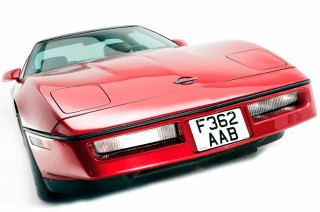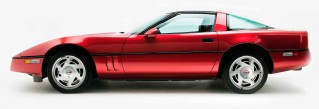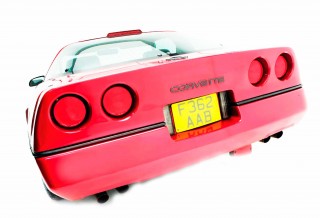It’s a cliché as old as the equally clichéd hills: when it comes to muscle cars, there ain’t no substitute for cubes. Except that, as the new four-cylinder Mustang proves pretty neatly, there is a substitute: forced induction. Still, this sort of behaviour doesn’t sit happily with the traditionalists of Americana – if it’s a fast car built in the USA, it needs to have a sodding great V8 in it.

The Corvette, icon that it is, has always been more sports car than muscle car, and with the mooted arrival of a mid-engined Corvette ruffling a few feathers (the horror!), fans are increasingly looking to the back catalogue for old-school big-motor thrills, all wrapped up in the traditional plastic body. The early C1- and C2-generation cars are commanding robust prices, and while the C3 of the 1970s has its fans, it’s still yet to enjoy true icon status despite creeping values. Which lands the aspiring ’Vette enthusiast squarely on the C4: built from 1984-1996, this was a fully redesigned model rather than an evolution of the C3, with rakish looks and brutal powerplants.

If it’s just mighty swept-volumes in gracefully ageing cars that tickles your fancy, the alternatives are plentiful, of course: TVR’s Chimaera, Griffith and any number of contemporary wedges all boasted benteights, while BMW and Jaguar each produced early-noughties supersaloons that rocked to the eight-cylinder beat. But if it just has to be a Corvette, then you’re in luck: with a production run spanning sixty-five years and seven generations, the two-seater Chevy doesn’t want for heritage, yet it’s never really taken off over here – maybe it’s the left-hand drive, or perhaps a reputation for poor build quality, but we implore you to put these issues to one side. The C4 has a lot to give, not least 350 noisy, gnarly all-American inches for very reasonable four-figure sums. Who could say no?
WHICH MODEL?
Like the curvy C3 that came before it, the C4 spent over a decade on the new car scene. Launched in 1984 and retired in 1996, the fourth-generation Corvette range spanned five engines, four transmissions, a major mid-life refresh and several special editions. Add a near endless collection of optional equipment and there’s plenty to discuss.

First thing’s first: no matter which C4 ‘Vette you choose, you’re guaranteed to get wedge styling and a 5.7-litre V8. Unlike its fibreglass forbears, the C4 wore moulded plastic panels, and the coupé version was the first Corvette to have a glass hatchback. (This generation was also available as a targa and a convertible.) A natty and oh-so eighties electronic dash was standard equipment and, given that power was relatively lower thanks to ever-changing emissions regs, a lot of emphasis was placed on chassis development to ensure that the 1980s Corvette was real-world fast.
We’re talking lightweight all-independent suspension, lightweight wheels, large brakes with aluminium calipers – it even featured a transverse fibreglass mono-leaf spring at the front, in place of traditional coils; this is a third of the weight of steel springs while also acting as an anti-roll bar. See, this wasn’t just dumb muscle-car grunt – this was an intelligent and holistic effort to build a capable and entertaining sports car.
Launch cars for the 1984 model year used the old L83 small-block, which produced 205bhp, but this was quickly usurped the following year by the more powerful and efficient L98 motor; still 5.7-litres, it initially offered 230bhp, climbing to 240bhp in 1987 with the addition of hydraulic lifters. The Callaway Twin-Turbo also appeared in ’1987 – an aftermarket model interestingly sold via GM dealers with an official warranty, this fiery affair took power to a stratospheric 345bhp.
Fans of rorty nat-asp motors were sated in 1990 with the introduction of the ZR-1, which ushered in the LT5 engine (once again, 5.7-litres) with 375bhp – the aluminium-blocked DOHC 32-valve motor was developed with help from Lotus, who’d recently been acquired by GM. The ZR-1 also had upgraded steering and braking along with active ride control, and is immediately recognisable by its wider tail and 11in-wide rear wheels. Quasi-supercar stuff.
![]()
The L98 motor in the standard Corvette was replaced by the 300bhp LT1 in 1992, when traction control became stock-issue, and the 330bhp LT4 V8 came in for 1996.
Some models of note include the Grand Sport, a run-out 1996 special in blue with a broad white stripe, the Indy 500 Pace Car Edition of 1995, and the Ruby Red 40th Anniversary Edition of 1993. Oh, and fans of wearing pastel-hued suits with the jacket sleeves rolled up to the elbows will enjoy the 35th Anniversary Edition of 1988, which sports white paint, white seats, white wheels and a white steering wheel. Tasteful.
ENGINE & TRANSMISSION
The L83 engine of the 1984 cars is a tricksy thing, its fuel-injection system effectively being a pair of ‘electronic carburettors’, which has its merits but is understood by few but the most dedicated Corvette fettlers. The L98 engines were more advanced with proper tuned-port fuel injection, and turned the C4 into a true 150mph car. This engine’s all about the lowdown power though, and very little happens above about 4,500rpm.
The LT engines were smoother and more economical than the L98, as well as being happier to rev. The Achilles’ heel is the Optispark system however, with an optically-referenced distributor mounted just under and behind the water pump, which can easily be killed by water leaks or condensation.
The LT5 engine is a very specialist thing, and its not uncommon to find them tuned to big numbers – simple headwork and induction/ exhaust upgrades can push them over 500bhp, although this can make them fragile. Ensure they idle properly, accelerate smoothly, maintain healthy temperature and don’t throw up any warning lights.
While many C4s were specced with the four-speed auto, there was also the option of the Doug Nash ‘4+3’ transmission – essentially a four-speed manual with automatic overdrive on the top three gears. An interesting approach, but this was ultimately replaced by the ZF 6-speed manual. If the car has the ZF, bear in mind that you’ll need to buy M Performance oil from your BMW dealer to maintain it.
BODYWORK & INTERIOR
One thing to look out for on any C4 is water ingress. Don’t be at all surprised if you find this, as the seals around the side windows and rear hatch (and targa tops, if present) are essentially consumables; furthermore a full set will cost you about £400. You won’t find any rust in the body panels of course, but check thoroughly underneath for rot in the chassis. Inside the car there are all sorts of hard, shiny plastics which are prone to scratching, and the seat leather isn’t exactly Rolls-Royce quality so you may find cracking and stretching along with the inevitable worn bolsters. Make sure that all elements of the digital dash are illuminating, and that the air-con’s working properly. If the car has the ‘FX3’ adjustable active ride control, you’ll spot a knob ahead of the centre console to adjust the electronic dampers – twiddling this should make the requisite lights appear on the dash, which should come on and then go out when you start the engine.
WHEELS, BRAKES & TYRES
The sawblade wheels are a C4 icon. Early cars’ wheels were 8.5x16in, with the rears growing to 9.5in-wide. 9.5x17in is most common, and the ZR-1’s rear wheels were a brawny 11x17in with 315-section rubber. Tyres are tricky to obtain in the correct size for the wide 16in wheels, and the common solution is to upgrade to 17in or 18in rims instead. (285-section 17in tyres are also relatively rare, but 275s will work well enough.) There’s a tyre pressure monitoring system too, so check this is working as having the light illuminated is an MoT failure – if it’s not working, it’ll probably just need new sensors. Brakes are up to the job in stock form – make sure the car brakes in a straight line, and check the pipes for corrosion.
STEERING & SUSPENSION
The adjustable steering column should move up and down freely, and telescope properly if it’s not an airbag-equipped wheel. There shouldn’t be any excessive play in the wheel, and the power steering should provide obvious assistance – although its not uncommon for the powered rack to need a bit of time to warm up; if it feels lethargic from cold or only assists in one direction, it may right itself after a few miles. This is an indication that the rack needs rebuilding. A quick-rack was also available, so check the history to see if the car has the ‘Z51’ option.
Suspension was designed in conjunction with Good Year and features aluminium forged components and composite transverse leaf springs front and rear – spring rates were actually lowered numerous times over the C4’s lifespan, as many felt the 1984 car was too stiff! It’s a robust setup, but give it a visual inspection to check for damage or wear before testing it with the seat of your pants to see if it feels even.
BUYING AND RUNNING
Count those cubes: no Corvette is going to be cheap to fuel, and owners report fuel economy in the mid-teens or low 20s. Other costs are less worrisome, with servicing and parts both remarkably inexpensive for the performance on offer. Bear in mind, however, that parts coming from the US attract import tax and take time to progress through customs.
All C4 Corvettes fall into the pre-2001 VED class, which differentiates on engine capacity and will cost £255 per annum for any classic ‘Vette owner. This is true no matter when any given car was imported into the UK, as the road tax system takes a vehicle’s initial overseas registration into account when setting vehicle age.
With so few Corvettes available on the British used market, it can take time, patience and compromise to find a car approaching your desired specification. Prices are hugely variable, with similar examples offered at very different prices, but careful searching can find almost any C4 variant below £10,000. As a general rule, running but imperfect early cars start just above £5,000, rising to £8,000 for a post-facelift car. Another £2,500 above these prices generally secures a well cared-for C4. Very late LT4-powered cars command more, while the ZR-1 and Grand Sport cost more still. The Callaway Twin Turbo holds substantially higher values than any standard ‘Vette – these are the £20k C4s.
ALSO CONSIDER
TVR GRIFFITH
You’ll need to reconfigure your budget by around 50% to get yourself into a Griff, but the rewards are obvious. This 1990s brute shares much with the Corvette, spiritually speaking: a body that belligerently isn’t made of metal, a rumbling V8 in the nose, and a keen engineering focus on chassis poise and agility. Early cars had a 240bhp version of the 4.0-litre Rover V8, increasing over time to 4.3-litres and, ultimately, a 340bhp 5.0-litre variant. (Just try to ignore the fact that it’s got Vauxhall Cavalier rear lights – once seen, that cannot be unseen…) £13k buys you into the club, although the sky’s the limit for nut-and-bolt restos, they can go for £60k+.
NISSAN 350Z
For similar money to the C4, you could find yourself a very decent example of Nissan’s new-wave Z-car hero. Packing a number of similar attributes to the C4 Corvette – sleek coupé (or drop-top) styling, brawny vee-engines, rear-drive hairiness – it also boasts muscle-car power. 2006-on cars had 300bhp, and a traditional American approach to options lists meant that this Japanese sweetheart was available in base, Enthusiast, Performance, Touring or Track spec levels. You get lightweight wheels with massive Brembos behind them, the option of an LSD, and oodles of pretty design details. A future classic, for sure. Prices start around £5k, and these cars are absurdly reliable too.
TECH SPEC 1995 CHEVROLET C4 CORVETTE
Layout: Front-engined, rear-wheel drive coupé or convertible
Engine: 5.7-litre LT1 V8
Max Power: 300bhp @ 5000rpm / DIN nett
Max Torque: 340lb-ft @ 4000rpm / DIN nett
Weight: 1544kg Top speed: 161mph
0-60mph: 5.1 sec
Max Speed 160mph
Economy: 15 mpg
Value: £9000 – £15,000
Thanks to the Corvette Car Club UK for their help with the feature.
‘IT ISN’T JUST DUMB MUSCLE CAR GRUNT, IT’S A CAPABLE SPORTS CAR’
EXPERT’S VIEW
PAUL ALLEN KNOWS the C4 inside out, having owned and run marque specialist Lincolnshire Corvette and Classic (lincolnshirecorvetteandclassic.com, 01400 283147) for three years. ‘I’ve been a mechanic forever,’ he explains, ‘and we used to race Formula 1 Stock Cars in short oval racing. They’re all powered by Chevrolet V8s, both small and big block, and many competitors used to struggle getting them repaired over here. That’s when we started working on cars here and there.
‘Pretty soon, it became clear there was a market for American cars, especially Corvettes. I’ve loved them since I was small: everyone remembers their first! I’m working with a guy called Adam and business is really good, we’re busy and have 3,300sq.ft garage. Owners don’t have many options when looking for a specialist who works with classic Americans and Corvettes; there aren’t many garages who will look at a C4 and then the car can get bodged.
‘When it was introduced, the C4 was a good-looking car which handled nicely and did everything it should do. It caused quite a stir, and 1995 and ’1996 cars are now fetching a lot of money. The digital dash is a major weakness on early cars, as is the Optispark on LT1-engined Corvettes, but other than that the C4 is brilliant and you get a lot for your money They’re reasonable on fuel, parts are available, and they’re not expensive. For some reason, they’ve never really caught on…’
OWNER’S VIEW
AFTER EIGHTEEN YEARS of Corvette ownership, Francis Sykes knows everything that’s anything about the C4. He even co-wrote the Corvette Car Club UK buyers’ guide for the model. ‘There are only about 200 C4s in the UK,’ he explains, ‘there aren’t loads and loads around. A lot of the more ragged cars have come off the road now, leaving just the ones that are in really good condition. The things with the C4 is they had a fair production span and, if you want to go back to the beginning, they were full of groundbreaking stuff. You can pay the price for that now… there a fair few bits and pieces which take a bit of fighting to get fixed. It’s not a difficult car to fix but you do need to know what you’re doing.
‘I got my first C4 in 2000, aged 24. It felt like driving a supercar and had a lot of performance at the top end: it could keep up with TVRs and the like. Despite the fact it was an auto, it was such a drive. They were quoted at 230bhp from the factory but I did a timed run at 5.7 seconds to 60mph so it did go and a lot of it was really low-down pull. That’s really characteristic of that engine; it’s really good from idle upwards but runs out around 4500rpm.
‘I fitted that Vette with an aftermarket exhaust and I remember, after an earthquake, one of my neighbours just said ‘I thought that was you going out in your car.’ That’s one of the best things that’s ever been said to me, I think! My red C4 looked great, drove well and I could just about afford to fuel it. I daily drove it at one point but also went to Hockenheim with it and used it for other bits of fun too. I took it on track at TRAX and, after the sighting lap, came into the corner having barely braked… I went off backwards and, as I was spinning, I could only think, ‘I don’t think I’ve got any towing points…’ I did about 40,000 miles in that car overall before trading it in for the 1995 Corvette I have now. It’s bolted together a lot better than the early cars but it’s a lot less noisy by comparison!
‘Some people know what it is but there are quite a few people who don’t. It’s got a look that can’t be repeated: pop-up headlights and a pushrod engine with a very low bonnet line. They accelerate well too and they do go round corners. I don’t mind too much about the left-hand-drive: 5.7 litres makes overtaking easier! It’s a car that’s really grabbed me. My wife has asked whether I’d change my current C4 for a later C5 or C6 and I don’t really want to. I’m very attached to it – I can’t really imagine not having one.’
‘I REALLY CAN’T IMAGINE NOT OWNING ONE’
C4 Corvette has a sharper look than the curvacious C3. Wood and leather – ‘Vette style. Port injected C4 V8.





